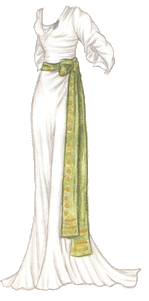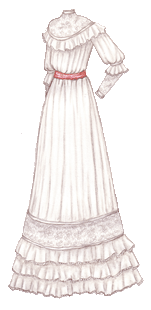 Click for larger version; click for the list of dolls.
Click for larger version; click for the list of dolls.
I finished The House Of Mirth the other day, which I had been listening to (specifically this version, read by Elizabeth Klett). I love the book, and the reading was so well done, but… my chores really suffer when I’m listening to a depressing audiobook. When I have one that I can’t wait to return to, I do some dishes or take a walk just to have the excuse to listen to it, but when it’s one, like this one, where you can’t do anything but watch Lily Bart make bad choices, get humiliated and reach for that chloral, and you know what’s going to happen to her and you can’t skim to read faster, it is hard to listen to all twelve hours of it. It’s such a lovely book but oh, so sad…
This dress, then, is a reminder of happier times for Lily, when she triumphed in the tableaux, dressed and positioned as this painting of Mrs. Richard Bennett Lloyd (maiden name Joanna Leigh), painted in 1775 by Sir Joshua Reynolds. She was the hit of the evening: “She had shown her artistic intelligence in selecting a type so like her own that she could embody the person represented without ceasing to be herself. It was as though she had stepped, not out of, but into, Reynolds’s canvas, banishing the phantom of his dead beauty by the beams of her living grace.” There is so much description of character and so little description of physical characteristics in the book that it seems as if this is as close as we get to Lily herself…
The two best references I could find for this dress are this full picture and this detail. Since they’re not as large as I would like and you can’t see all the detail, the dress isn’t perfectly accurate. The sash is, I think, entirely wrong, but for the life of me I cannot figure out how the bunched-up green drapery at the back actually works as part of a dress. I studied it, I sketched it, I brought it into Photoshop and played with the levels and contrast and brightness and it just seems to me like a big clump of fabric stuck to her side, so I decided to turn it into a sash and not worry about it. So please don’t use this in your “House of Mirth” book report, and should you get a chance to see this painting in person, please don’t leave me a comment about how I didn’t get it right. Or if you do, at least take some pictures for me.
So, now I’m listening to Deadwood Dick’s Doom; or, Calamity Jane’s Last Adventure, which means that there are buckskins waiting for Sylvia and Iris…
Very interesting answers to the poll so far, by the way! I wonder how much it would have changed if I had had a “from Go Fug Yourself” option… I posted the link to the Bai Ling green and purple outfit in the first few comments of the final Fug Madness post, and I got a ton of traffic for that post…
 Share
Share